5 Easy Yoga Poses to Relieve Stress
Feeling stagnated and stuck? Need to relieve stress? Try these yoga poses to get you through the slump.
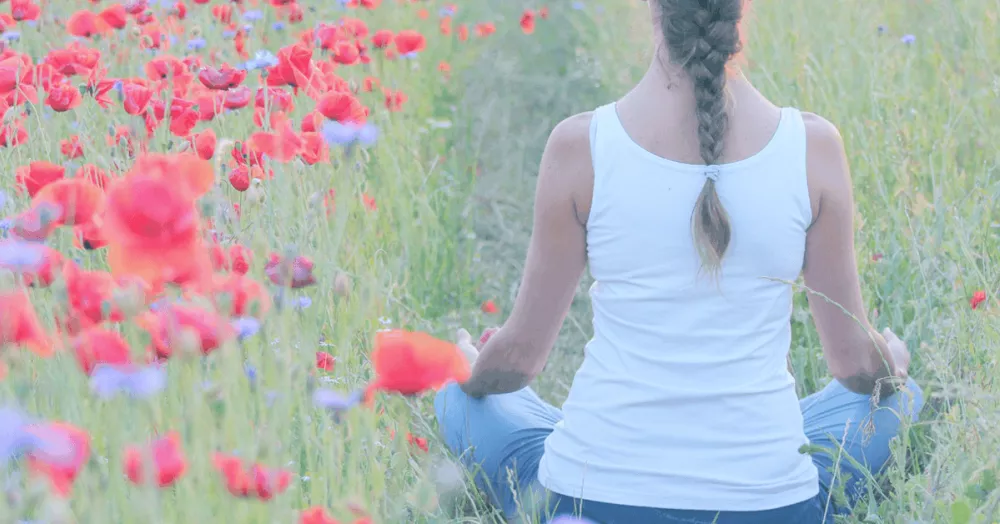
When we do not have a minute of free time, and the body is in constant tension, our body’s energy tends to stagnate. Our modern way of life is filled with distraction and technology, but our bodies and spirit are still drawn to silence.
If you are reading this slouched at your desk or on your couch, this short (but helpful) article is for you. Yoga may seem overwhelming if you are a beginner, but its health benefits are evident and abundant. Yoga has shown to improve balance, flexibility, improve posture, and quality of rest among other benefits. The key pillars of yoga are breathing, meditative alertness, and movement. So, whether you are a beginner who wants to improve flexibility (and touch your toes) or are looking for a simple stretch that calms your mind in the middle of a busy workday, yoga is for you.
Read on to learn our team’s goto yoga poses that enhance stability and relax those tense muscles. We also list down basic steps to prepare yourself for practice. Each pose has a detailed explanation about its significance and pointers to keep in mind while, so you can reap optimum benefits. Hope these effective yet easy yoga asanas make you stronger and calmer.
Before you begin, please note that if you have any physical injuries, pre-existing conditions, or if you are pregnant, consult with your doctor before trying these poses on your own.
Lets pause now. Take a deep breath. Let us go back to our bodies. Let us relax our tense muscles and begin.
Preparing for the Practice
These tips will help you make your practice most effective. You will need an anti-slip yoga mat to practice and additional supports depending on your experience level.
- Set a goal to exercise for at least 20 minutes a day. Choose a time to practice, preferably the same one every day. Ideally, practice in the morning, before the start of the working day. That way, you won't miss it because of meetings or deadlines.
- Set a calendar reminder. And make time for it when you plan your day.
- Try not to eat anything two hours before practice. It is best to exercise on an empty stomach to do deep crunches, inverted poses, and abdominal strengthening positions.
- Find a clean, ventilated, and distraction-free zone. Yoga is meditation too, so prepare like so. Turn off your phone and other devices.
- Wear well-fitted clothes that do not interfere with the movement of your body. Many poses involve a semi-inverted position with support on the palm, so they should not be loose, fall on the face and interfere with breathing.
- You will need a non-slip mat, two yoga bricks, and a belt. At first, instead of bricks, you can use thick books and instead of a belt - a long narrow towel.
- Spread out the mat. You should be able to stretch your arms and legs out to the sides and up.
- Flexibility is not the main requirement for yoga. In asanas, rely on your feelings, not on the appearance of the posture.
- Drink plenty of water, especially after class.
- And let you have fun! Light-heartedness and a positive attitude are very important if you want your practice not to bore you.
Importance of the First Pose
The first pose on the mat is an opportunity to listen to our bodies and draw away from the noises of everyday life. The as you calm down; direct your attention within to achieve the unity of body, mind, and spirit. The first pose also lays the foundation for subsequent asanas. The first pose is always soft, comfortable, and helps you focus on your breathing.
It usually takes up to five minutes to complete. It may take you a while to "turn off your head" and feel your whole body, so take your time, give yourself a chance to tune in to the breath before moving on. When you feel in sync with the rhythm of breathing, you can begin to move. During the practice, you can return to the starting position to rest, restore balance and even just breathe.
The Child's Pose (Balasana)
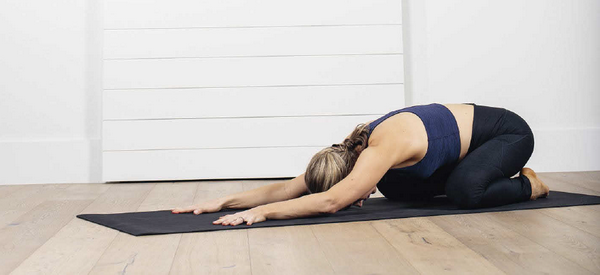
The child’s pose allows you to feel the connection between the breath and the body and fills all muscles with calming energy. It makes it possible to "ground" us and listen to what is happening inside us. Now start taking deep breaths and focus on the body. Feel your lungs expand as you take deep breaths.
The child's pose can be performed at any time during the session. If breathing becomes difficult as you are getting started or sluggish because you are distracted, the child's pose will help you reconnect with your breath and your purpose of the practice.
Execution Technique
- Sit on your knees and heels on the back edge of the mat. Connect your big toes. Spread your knees out to the edges of the mat so that your ribs rest between your thighs when you lie down on the floor. This also protects your knees as you perform the pose.
- Press your seat bones into your heels. Stretch your arms forward, spread your fingers and rest your bases under your fingers on the floor.
- Lower your forehead onto the mat and soften your shoulders.
- Fill the intercostal space with each breath. With each exhalation, gently pull up and draw in your lower abdomen.
The Tabletop Pose (Bharmanasana)
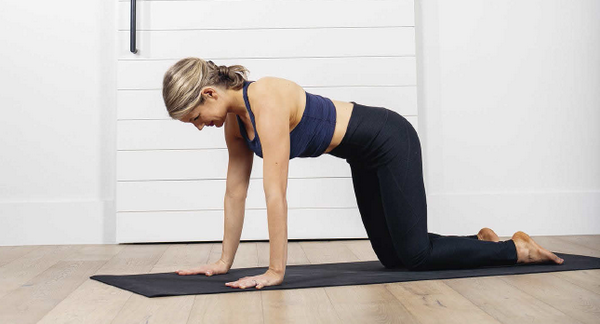
Table Pose is also a neutral pose that is performed on all fours. It can be done in place of the Downward Dog Pose, as a rest pose, or even as an intermediate Pose.
Execution Technique
- Get on all fours with your shoulders over your wrists and your hips over your knees. Feet can be folded back and pressed to the floor with their upper part, or with toes tucked in (more stable position).
- Standing on all fours, stretch your tailbone back and the crown forward.
- Point the bases of your palms towards your knees to activate your abdominal and back muscles. Pull-on your lower abdomen gently.
The Cat and Cow Pose (Marjariasana and Bitilasana)
A cat and a cow are two different poses that are usually done together while breathing in a breathing rhythm. This sequence of two postures gently activates and awakens the energy along the spinal column, as the movement in it is associated with breathing. It develops the flexibility of the entire spine, neck, and shoulders.
Execution Technique
- Take the tabletop pose, standing on all fours, palms under the shoulders, knees under the hips. Curl your toes for stability and tighten your lower abdomen.
- While inhaling, relax your stomach, bring your shoulder blades together and open your chest. Look up. This is the cow pose.
- As you exhale, round your back into the cat pose. Push off the floor and reach with your chin towards your chest.
- Repeat this for 10 breaths. Inhale - cow pose, exhale - cat pose. Then return to table pose.
The Knees to Chest Pose (Apanasana)
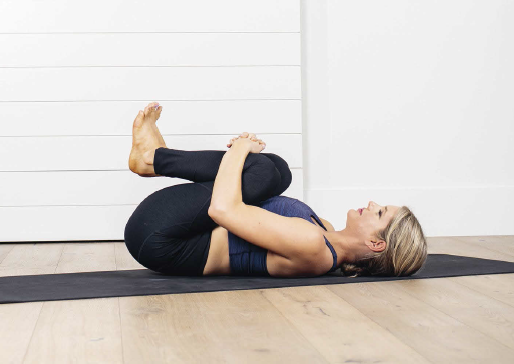
The knees to chest pose is soothing transitional and neutralizing. It is a lower backbend position that can be used throughout the practice. It stretches the lower back and helps with digestive ailments. In this position, we hug ourselves, so it reminds us of the feeling of self-love. This pose is like giving ourselves a big hug.
Execution Technique
- Lie on your back and bring both knees to your chest.
- Wrap your hands around your shins or grab your legs under your knees. Curl up into a ball.
- Point your heels away from you and your toes towards you to help protect your knees and ankles.
The Supported Hero’s Pose (Virasana)
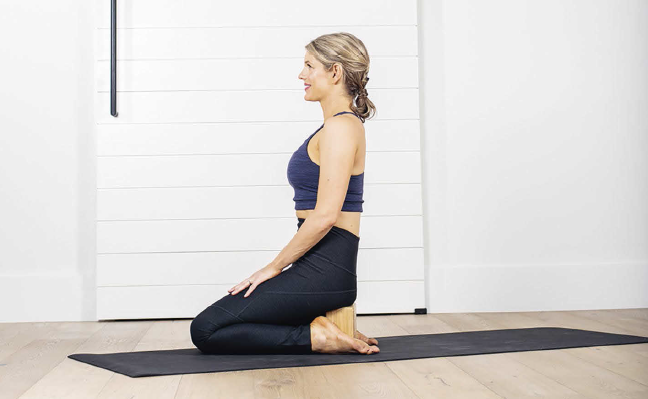
The Supported Hero’s Pose is an alternative meditation pose. It helps ground us by making the pelvis heavier. Virasana stretches the thighs and pelvis muscles, knees, legs, and feet and improves blood circulation in the lower half of the body. It relieves leg fatigue and strengthens the feet.
Execution Technique
- Kneel on the floor with your shins parallel to each other. Toes look at the back edge of the mat, and the heels are at the width of the pelvis.
- Lower your pelvis onto a brick, book, pillow, or folded blanket, placing the support between your feet, so your hips and pelvis are above your knees. Both ischial bones should be supported, and the pelvis should be in a neutral position.
- Move your knees. Place your palms on your hips - they can be lowered down or turned up.
- Raise your shoulders to your ears, then make a circle with your shoulders back and lower them; open your chest. Point your tailbone towards the floor.
- Look straight ahead at one point or close your eyes and listen for your breath.
We hope these yoga poses help you in relax and move about your energies. Do these poses anytime you feel stressed, disconnected, or just need a break from the screen. Do let us know your favourite pose in the comments.








Comments
I felt relaxed after doing these poses, thank you
[Comment marked as inappropriate]